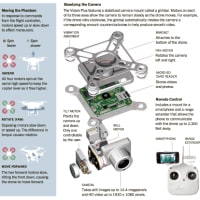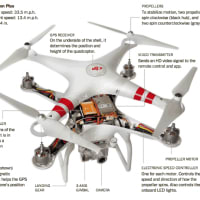Voyager 1 Speeds Toward The Brink Of Interstellar Space
ボイジャー1号は恒星間空間の淵にむけて加速しているby BILL CHAPPELL
December 26, 2011
こと宇宙になるとスケールが桁外れに大きくなるので、実感がわかないが、そういう遠方にボイジャー1号がいるということは事実で、想像するだけでわくわくする。

NASA/JPL-Caltech
An artist's conception shows Voyager 1 encountering a stagnation region. To the left is interstellar space. イラストレーターの概念図はボイジャーが淀み領域を通解していることを示している。 絵の左側は恒星間空間。
The Voyager 1 spacecraft is 11 billion miles from the sun. And every minute, it gets 636 miles closer to its destination: the frontier of interstellar space.
ボイジャー1号は太陽から110億マイル(177億km)を飛行中であり、毎分636マイル(約1000km)の速度で、未知の空間である恒星間空間に接近している。
The craft is currently in what NASA calls, not undramatically, "the boundary between the solar wind from the Sun and the interstellar wind from death-explosions of other stars," an area that astrophysicists also call, less dramatically, a stagnation layer.
ボイジャー1号は現在、NASAが言う、いわゆる、あまりドラマチックではないところ、すなわち太陽からの太陽風と他の星の死滅爆発からの恒星間風の間の境界付近で天文学者達が、あまりドラマチックではない淀み領域層に入っている。
When Voyager 1 crosses that threshold, it'll become the first man-made object to do so. That feat, along with the recent discovery of Kepler-22b, a potentially inhabitable planet, means that it's an exciting time to be an astrophysicist. Now, NASA and its two Voyager craft are heading into the great beyond.
ボイジャー1号がその領域を超えると、人工物として初めてのこととなる。 その偉業は最近の生命の存在の可能性のあるケプラー22bの発見とともに、天文学者にとって非常に興味の尽きない興奮の時がやってくることを意味している。 いま、NASAとその二つのボイジャーは偉大な宇宙空間へと向かっている。
"We're still bathed by the same solar wind that we have been for the last 30-some years," Voyager program chief scientist Dr. Ed Stone tells NPR's Steve Inskeep, in an interview airing on Monday's Morning Edition.
「我々は未だに、この30数年間受けてきた同じ太陽風を浴びている。」とボイジャー計画の主任科学者であるエド・ストーン博士はNPRのスティーブ・インスキープのインタビューに答えている。
That solar wind emanates from (you guessed it) the sun, and it travels at anywhere from around 1 million to 2 million miles an hour. The wind is extremely weak in the outer edges of the solar system, where Voyager is traveling. Stone says it creates a comet-shaped "bubble" around our solar system.
文字通り、太陽風は太陽から吹いている、そしてそれは太陽から毎時約1000万~2000万マイル(1600万キロ~3200万キロ)で吹いている。 その太陽風は太陽系の端では極端に弱くなっており、そこをボイジャーは通過している。 ストーン博士は彗星の形をしたバブル層が太陽系の周りにはあるという。
"But once we leave the bubble, we will be, for the first time, surrounded by winds that came from the explosion of other stars," says Stone, who has been Voyager's lead scientist since 1972.
「しかし、そのバブル層を通過して出ると、我々は、初めて恒星爆発から吹く風に覆われることになる。」と1972年からボイジャー計画の担当主任科学者のストーン博士は言う。
As it goes where no man-made thing has gone before, Voyager 1 will not be able to let us know if it sees something truly remarkable out there — because it no longer sees anything, in the traditional sense.
「ボイジャー1号が、かつて人工物が到達したことのないところへ入るわけで、ボイジャー1号はそこで本当に特異な何かを発見するか我々に伝えることは出来ないだでしょう。 なぜなら、ボイジャーが見るものは、これまでの私達に概念の中にすら存在しないものだからです。」
"We turned off all the cameras in 1990," Stone says, "and all the other instruments that were designed just to look at bodies as we flew by. Space is really empty. And Voyager will never be very close to any other object in our solar system, or even in our galaxy, for that matter."
「1990年に我々は全てのカメラを止めました、そして全ての装置も、それらは我々が通り過ぎた物体(星等)をみるよう設計されていたのです。 宇宙空間は本当に無なのです。 そしてボイジャーは我々太陽系のどの物体にも決して接近することは無いのです。 いや銀河系にすらもないのです。

A technician holds a U.S. flag over a gold record containing data from Earth, with a Voyager spacecraft in the background. 技術者が地球からのデータを記録した金のレコードの上で合衆国木を掲げている。 後ろにあるのがボイジャー本体。
That paints a rather lonely picture. But at least Voyager 1 is being trailed by its sibling craft, Voyager 2, which is about 9 billion miles from the sun. In total, the two probes have traveled even farther — they've each logged more than 14 billion miles, as they diverted their courses to study planets in our solar system, NASA says. The agency has created an animated video depicting their paths.
これまでの説明は少なからずボイジャー1号の孤独な寂寥としたイメージを抱かせるが、少なくともボイジャー1号は、その兄弟機であるボイジャー2号が追尾しているのである。2号機は太陽から90億マイル(144億キロ)の地点を飛行している。 この2機の探査機は合計で、更に長い距離を飛行していることになる・・・彼らは140億マイル(224億キロ)に及ぶ宇宙の旅を記録しているが、太陽系の惑星を研究するために、この2機は異なった軌道を旅しているとNASAは説明している。 NASAは彼らの軌道をえがいたアニメのビデオを作成している。
Of course, the edge of interstellar space will not be marked with a handy "Now Leaving Your Solar System" sign. Scientists hope that Voyager will give them more clues about where interstellar space actually begins, and where the bubble ends, as it crosses over the boundary.
もちろん、恒星間空間の端というのは、簡単に「今太陽系を出ました」と合図を出せるように認識されるものではない。 科学者たちは、ボイジャーが、その境界を超えるときに、どこから実際に恒星間宇宙が始まるのか、どこでバブル層が終わるのかの手掛かりを伝えてくれるだろうと期待している。
"We have only had estimates," Stone says. "The estimates varied by a factor of two... the size of the bubble is determined by this pressure of the wind blowing outward, pushing against the wind outside. And we don't know exactly... how much pressure there is outside, pushing back."
「私達は単に推測しているのですが、その推測でさえ、例えばバブルの大きさは、太陽風に反対の、外へ向かう風の圧力で決定されるのですが、ハッキリ分らないのです。どれだけの圧力が逆方向に働いているのか・・」
"My expectation is that it's probably, at most, another billion miles," Stone says, "and may in fact be only a few hundred million miles, before we reach the edge of the bubble. We're getting very close now."
「私の期待値は、バブルの直径は、およそ最大で数十億マイルだと思うのですが、実際は、バブルの端に届くのは数千マイルかも知れないのです。 とにかく、我々はかなり接近しているのです。」
So at the most, Stone says, Voyager 1 will leave our solar system within three years. And when it does, NASA wants some answers.
だから、早ければボイジャー1号は太陽系を3年以内に離脱するでしょう。 その時、NASAは何か掴むことを望んでいるのです。
"We want to explore interstellar space itself," Stone says. "We have some ideas of what's out there, from data, and observations from Earth. We believe that we are in a cloud of material that was ejected by the explosion of a series of supernova, about 5 to 10, 15 million years ago, very near the sun. And that we will be embedded in the material from those giant explosions, and the magnetic field which was swept up by the shells of material ejected by those exploding stars. So, we're very interested in learning more precisely what's really outside of the bubble, pressing back inward."
「我々は恒星間空間それ自体を探索したいと考えているのです、我々には、データや地球からの観測結果から、そこが一体どのようなものなのかというある想定はしています。 我々は太陽系に非常に近い、約500万~1500万年前に、一連の超新星の爆発によって噴出された物質の雲の中にいると考えられています。 そして我々はそれらの巨大な爆発から生まれた物質のなかに埋め込まれているのです、そして爆発した、それらの星のかけらによって磁場は飲み込まれているのです。 だから、我々は内側に押している、バブルの外に本当に何があるのか、もっと正確に知りたいのです。
Once they've reached interstellar space, the Voyager spacecraft will also have a chance to deliver their golden cargo — the data records that include 116 pictures, along with sounds from Earth. The discs includes songs from Louis Armstrong, Beethoven, and a Navajo tribe.
探査機が恒星間空間に達すると、ボイジャーは黄金の荷物を射出します、それは116の映像を含む記録と地球からのメッセージの音声です。 そのディスクにはルイ・アームストロング、ベートーベン、ナバホ―インディアンの録音が含まれています。
And in Amoy, a language from eastern China, the records carry this message: "Friends of space, how are you all? Have you eaten yet? Come visit us if you have time."
そして、東シナ海の言語であるアモイの言葉でメッセージが入れてあります。「宇宙の皆さんへ、ご機嫌いかがですか? もう食事は終わりましたか? 時間があれば我々を訪れて下さい。」
It may seem risky to send an open invitation to the universe that tells alien races to stop by for a bite. But it's not as if Earth can send many invitations. That's because of the unique way our solar system's planets were aligned in 1977, when the Voyager craft were launched.
宇宙空間にもろ手で、宇宙人衣食事ために立ち寄るように招待状を送るのは危険かもしれません、しかし、地球がそうそう沢山の招待状を出せると言う訳でもないでしょう。 だから、私達の太陽系の惑星が1977人に一列に重なる貴重なタイミングで、ボイジャーを打ち上げたのです。
"That was an opportunity that happens every 176 years," Stone says, "to send a spacecraft past all four of the giant outer planets: Jupiter, Saturn, Uranus and Neptune."
「このように、探査機が我々の主な惑星つまり、木星、土星、天王星、海王星が一列に揃い、それらを全て通過することが出来る機会は176年周期で訪れます。」
The Voyager spacecraft are expected to stay functional until at least 2020, and possibly until 2025.
ボイジャーは少なくとも2020年までは機能すると思われますし、2025年くらいまでは持つ可能性があります。
Toward the end of the interview, Stone said that in the Voyager mission, every day seems to bring a new revelation about our solar system. In doing so, he voiced an opinion that wouldn't be out of place on the space probes' gold records. "No matter what you think you know," he said, "what there is to learn is even more interesting."
このインタビューの終わりに、ストーン博士はボイジャーのミッションの中に、我々太陽系について日々新しい発見をもたらしてくれることだと言いました。 そう言いながら、彼は宇宙探査機の黄金の記録にふさわしい意見を言いました。 「私達が、何かをどんなに知ろうとも、知ることがあるということに、より興味が沸いてくる。」
※ ボイジャー1号・2号が相次いで打ち上げられたのは、今からもう30年以上前の
1977年8月と9月のことです。
では、なぜこの年に打ち上げられたのでしょう。
それは、木星、土星、天王星、海王星を一度で巡ることのできる176年に一回しか
ないチャンスだったのです。この年を逃したらまた176年待たなければなりません。
打ち上げてすぐにトラブルがあったのですが、その後は順調に旅を続けました。
1号は、1979年に木星のそばを通過して1980年11月に土星のそばを
通過しました。
2号は、1977年に木星のそばを通過、1981年に土星、1986年に天王星
1989年に海王星のそばをそれぞれ通過しました。
彼の全ては、原子力エネルギー(プルトニウム)で動きます。
彼の目(カメラ)は、800メートル先からでも新聞の字が読めるほどでした。
広域を撮影するための広角カメラとアップの写真を撮影するための望遠カメラの2台を
搭載しています。
彼が送ってくれた膨大な写真は、どのようにして地球に届くのでしょう。
わずか20Wの電波に乗せて宇宙の彼方から発信するのですが例えば地球から
45億km離れた海王星から地球に届くまでには4時間かかります。
そして、その力は、1億分の1のそのまた1億分の1ワットにまで減少しています。
そのかすかな電波を地球に3ヶ所ある巨大なアンテナで受信し画像処理をして人間が
行って見ることのできない美しく謎に満ちた数々の映像を見ることができるように
なるのです。
ボイジャー1号は恒星間空間の淵にむけて加速しているby BILL CHAPPELL
December 26, 2011
こと宇宙になるとスケールが桁外れに大きくなるので、実感がわかないが、そういう遠方にボイジャー1号がいるということは事実で、想像するだけでわくわくする。

NASA/JPL-Caltech
An artist's conception shows Voyager 1 encountering a stagnation region. To the left is interstellar space. イラストレーターの概念図はボイジャーが淀み領域を通解していることを示している。 絵の左側は恒星間空間。
The Voyager 1 spacecraft is 11 billion miles from the sun. And every minute, it gets 636 miles closer to its destination: the frontier of interstellar space.
ボイジャー1号は太陽から110億マイル(177億km)を飛行中であり、毎分636マイル(約1000km)の速度で、未知の空間である恒星間空間に接近している。
The craft is currently in what NASA calls, not undramatically, "the boundary between the solar wind from the Sun and the interstellar wind from death-explosions of other stars," an area that astrophysicists also call, less dramatically, a stagnation layer.
ボイジャー1号は現在、NASAが言う、いわゆる、あまりドラマチックではないところ、すなわち太陽からの太陽風と他の星の死滅爆発からの恒星間風の間の境界付近で天文学者達が、あまりドラマチックではない淀み領域層に入っている。
When Voyager 1 crosses that threshold, it'll become the first man-made object to do so. That feat, along with the recent discovery of Kepler-22b, a potentially inhabitable planet, means that it's an exciting time to be an astrophysicist. Now, NASA and its two Voyager craft are heading into the great beyond.
ボイジャー1号がその領域を超えると、人工物として初めてのこととなる。 その偉業は最近の生命の存在の可能性のあるケプラー22bの発見とともに、天文学者にとって非常に興味の尽きない興奮の時がやってくることを意味している。 いま、NASAとその二つのボイジャーは偉大な宇宙空間へと向かっている。
"We're still bathed by the same solar wind that we have been for the last 30-some years," Voyager program chief scientist Dr. Ed Stone tells NPR's Steve Inskeep, in an interview airing on Monday's Morning Edition.
「我々は未だに、この30数年間受けてきた同じ太陽風を浴びている。」とボイジャー計画の主任科学者であるエド・ストーン博士はNPRのスティーブ・インスキープのインタビューに答えている。
That solar wind emanates from (you guessed it) the sun, and it travels at anywhere from around 1 million to 2 million miles an hour. The wind is extremely weak in the outer edges of the solar system, where Voyager is traveling. Stone says it creates a comet-shaped "bubble" around our solar system.
文字通り、太陽風は太陽から吹いている、そしてそれは太陽から毎時約1000万~2000万マイル(1600万キロ~3200万キロ)で吹いている。 その太陽風は太陽系の端では極端に弱くなっており、そこをボイジャーは通過している。 ストーン博士は彗星の形をしたバブル層が太陽系の周りにはあるという。
"But once we leave the bubble, we will be, for the first time, surrounded by winds that came from the explosion of other stars," says Stone, who has been Voyager's lead scientist since 1972.
「しかし、そのバブル層を通過して出ると、我々は、初めて恒星爆発から吹く風に覆われることになる。」と1972年からボイジャー計画の担当主任科学者のストーン博士は言う。
As it goes where no man-made thing has gone before, Voyager 1 will not be able to let us know if it sees something truly remarkable out there — because it no longer sees anything, in the traditional sense.
「ボイジャー1号が、かつて人工物が到達したことのないところへ入るわけで、ボイジャー1号はそこで本当に特異な何かを発見するか我々に伝えることは出来ないだでしょう。 なぜなら、ボイジャーが見るものは、これまでの私達に概念の中にすら存在しないものだからです。」
"We turned off all the cameras in 1990," Stone says, "and all the other instruments that were designed just to look at bodies as we flew by. Space is really empty. And Voyager will never be very close to any other object in our solar system, or even in our galaxy, for that matter."
「1990年に我々は全てのカメラを止めました、そして全ての装置も、それらは我々が通り過ぎた物体(星等)をみるよう設計されていたのです。 宇宙空間は本当に無なのです。 そしてボイジャーは我々太陽系のどの物体にも決して接近することは無いのです。 いや銀河系にすらもないのです。

A technician holds a U.S. flag over a gold record containing data from Earth, with a Voyager spacecraft in the background. 技術者が地球からのデータを記録した金のレコードの上で合衆国木を掲げている。 後ろにあるのがボイジャー本体。
That paints a rather lonely picture. But at least Voyager 1 is being trailed by its sibling craft, Voyager 2, which is about 9 billion miles from the sun. In total, the two probes have traveled even farther — they've each logged more than 14 billion miles, as they diverted their courses to study planets in our solar system, NASA says. The agency has created an animated video depicting their paths.
これまでの説明は少なからずボイジャー1号の孤独な寂寥としたイメージを抱かせるが、少なくともボイジャー1号は、その兄弟機であるボイジャー2号が追尾しているのである。2号機は太陽から90億マイル(144億キロ)の地点を飛行している。 この2機の探査機は合計で、更に長い距離を飛行していることになる・・・彼らは140億マイル(224億キロ)に及ぶ宇宙の旅を記録しているが、太陽系の惑星を研究するために、この2機は異なった軌道を旅しているとNASAは説明している。 NASAは彼らの軌道をえがいたアニメのビデオを作成している。
Of course, the edge of interstellar space will not be marked with a handy "Now Leaving Your Solar System" sign. Scientists hope that Voyager will give them more clues about where interstellar space actually begins, and where the bubble ends, as it crosses over the boundary.
もちろん、恒星間空間の端というのは、簡単に「今太陽系を出ました」と合図を出せるように認識されるものではない。 科学者たちは、ボイジャーが、その境界を超えるときに、どこから実際に恒星間宇宙が始まるのか、どこでバブル層が終わるのかの手掛かりを伝えてくれるだろうと期待している。
"We have only had estimates," Stone says. "The estimates varied by a factor of two... the size of the bubble is determined by this pressure of the wind blowing outward, pushing against the wind outside. And we don't know exactly... how much pressure there is outside, pushing back."
「私達は単に推測しているのですが、その推測でさえ、例えばバブルの大きさは、太陽風に反対の、外へ向かう風の圧力で決定されるのですが、ハッキリ分らないのです。どれだけの圧力が逆方向に働いているのか・・」
"My expectation is that it's probably, at most, another billion miles," Stone says, "and may in fact be only a few hundred million miles, before we reach the edge of the bubble. We're getting very close now."
「私の期待値は、バブルの直径は、およそ最大で数十億マイルだと思うのですが、実際は、バブルの端に届くのは数千マイルかも知れないのです。 とにかく、我々はかなり接近しているのです。」
So at the most, Stone says, Voyager 1 will leave our solar system within three years. And when it does, NASA wants some answers.
だから、早ければボイジャー1号は太陽系を3年以内に離脱するでしょう。 その時、NASAは何か掴むことを望んでいるのです。
"We want to explore interstellar space itself," Stone says. "We have some ideas of what's out there, from data, and observations from Earth. We believe that we are in a cloud of material that was ejected by the explosion of a series of supernova, about 5 to 10, 15 million years ago, very near the sun. And that we will be embedded in the material from those giant explosions, and the magnetic field which was swept up by the shells of material ejected by those exploding stars. So, we're very interested in learning more precisely what's really outside of the bubble, pressing back inward."
「我々は恒星間空間それ自体を探索したいと考えているのです、我々には、データや地球からの観測結果から、そこが一体どのようなものなのかというある想定はしています。 我々は太陽系に非常に近い、約500万~1500万年前に、一連の超新星の爆発によって噴出された物質の雲の中にいると考えられています。 そして我々はそれらの巨大な爆発から生まれた物質のなかに埋め込まれているのです、そして爆発した、それらの星のかけらによって磁場は飲み込まれているのです。 だから、我々は内側に押している、バブルの外に本当に何があるのか、もっと正確に知りたいのです。
Once they've reached interstellar space, the Voyager spacecraft will also have a chance to deliver their golden cargo — the data records that include 116 pictures, along with sounds from Earth. The discs includes songs from Louis Armstrong, Beethoven, and a Navajo tribe.
探査機が恒星間空間に達すると、ボイジャーは黄金の荷物を射出します、それは116の映像を含む記録と地球からのメッセージの音声です。 そのディスクにはルイ・アームストロング、ベートーベン、ナバホ―インディアンの録音が含まれています。
And in Amoy, a language from eastern China, the records carry this message: "Friends of space, how are you all? Have you eaten yet? Come visit us if you have time."
そして、東シナ海の言語であるアモイの言葉でメッセージが入れてあります。「宇宙の皆さんへ、ご機嫌いかがですか? もう食事は終わりましたか? 時間があれば我々を訪れて下さい。」
It may seem risky to send an open invitation to the universe that tells alien races to stop by for a bite. But it's not as if Earth can send many invitations. That's because of the unique way our solar system's planets were aligned in 1977, when the Voyager craft were launched.
宇宙空間にもろ手で、宇宙人衣食事ために立ち寄るように招待状を送るのは危険かもしれません、しかし、地球がそうそう沢山の招待状を出せると言う訳でもないでしょう。 だから、私達の太陽系の惑星が1977人に一列に重なる貴重なタイミングで、ボイジャーを打ち上げたのです。
"That was an opportunity that happens every 176 years," Stone says, "to send a spacecraft past all four of the giant outer planets: Jupiter, Saturn, Uranus and Neptune."
「このように、探査機が我々の主な惑星つまり、木星、土星、天王星、海王星が一列に揃い、それらを全て通過することが出来る機会は176年周期で訪れます。」
The Voyager spacecraft are expected to stay functional until at least 2020, and possibly until 2025.
ボイジャーは少なくとも2020年までは機能すると思われますし、2025年くらいまでは持つ可能性があります。
Toward the end of the interview, Stone said that in the Voyager mission, every day seems to bring a new revelation about our solar system. In doing so, he voiced an opinion that wouldn't be out of place on the space probes' gold records. "No matter what you think you know," he said, "what there is to learn is even more interesting."
このインタビューの終わりに、ストーン博士はボイジャーのミッションの中に、我々太陽系について日々新しい発見をもたらしてくれることだと言いました。 そう言いながら、彼は宇宙探査機の黄金の記録にふさわしい意見を言いました。 「私達が、何かをどんなに知ろうとも、知ることがあるということに、より興味が沸いてくる。」
※ ボイジャー1号・2号が相次いで打ち上げられたのは、今からもう30年以上前の
1977年8月と9月のことです。
では、なぜこの年に打ち上げられたのでしょう。
それは、木星、土星、天王星、海王星を一度で巡ることのできる176年に一回しか
ないチャンスだったのです。この年を逃したらまた176年待たなければなりません。
打ち上げてすぐにトラブルがあったのですが、その後は順調に旅を続けました。
1号は、1979年に木星のそばを通過して1980年11月に土星のそばを
通過しました。
2号は、1977年に木星のそばを通過、1981年に土星、1986年に天王星
1989年に海王星のそばをそれぞれ通過しました。
彼の全ては、原子力エネルギー(プルトニウム)で動きます。
彼の目(カメラ)は、800メートル先からでも新聞の字が読めるほどでした。
広域を撮影するための広角カメラとアップの写真を撮影するための望遠カメラの2台を
搭載しています。
彼が送ってくれた膨大な写真は、どのようにして地球に届くのでしょう。
わずか20Wの電波に乗せて宇宙の彼方から発信するのですが例えば地球から
45億km離れた海王星から地球に届くまでには4時間かかります。
そして、その力は、1億分の1のそのまた1億分の1ワットにまで減少しています。
そのかすかな電波を地球に3ヶ所ある巨大なアンテナで受信し画像処理をして人間が
行って見ることのできない美しく謎に満ちた数々の映像を見ることができるように
なるのです。




















※コメント投稿者のブログIDはブログ作成者のみに通知されます